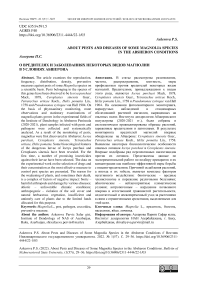About pests and diseases of some magnolia species in the Absheron conditions
Автор: Askerova Parviz S. gizi
Журнал: Вестник Нижневартовского государственного университета @vestnik-nvsu
Рубрика: Экология микроорганизмов, растений
Статья в выпуске: 1, 2022 года.
Бесплатный доступ
The article examines the reproduction, frequency, distribution, density, preventive measures against pests of some Magnolia species on a scientific basis. Pests belonging to the species of this genus have been observed to be Icerya purchasi Mack, 1878, Ceroplastes sinensis Guer., Tetranychus urticae Koch., Helix pomatia Lin., 1758 and Pseudomonas syringae van Hall 1904. On the basis of phytosanitary monitoring, route observations and stationary examinations of magnolia plants grown in the experimental fields of the Institute of Dendrology in Absheron Peninsula (2020-2021), plant samples infected with pests and pathogens were collected and systematically analyzed. As a result of the monitoring of pests, magnolias were first discovered in Absheron: Icerya purchasi, Ceroplastes sinensis, Tetranychus urticae, Helix pomatia. Some bioecological features of the dangerous larvae of Icerya purchasi and Ceroplastes sinensis have been revealed. For the first time, a number of promising insecticides against their larvae have been selected. The data on the experimental work on the selection of drugs and their concentration as the most effective measure to control pest species are presented. The reason for the weakening of plants, and sometimes their death, is a complex of factors of negative impact: biotic - harmful arthropods and damage by various diseases; abiotic - unfavorable climatic conditions; anthropogenic - violation of the soil cover and natural herbaceous vegetation, insufficient and untimely care of plants due to the limited funds allocated for this purpose.
Pest, pathogen, coccoidea, preventive measure
Короткий адрес: https://sciup.org/14123611
IDR: 14123611
Список литературы About pests and diseases of some magnolia species in the Absheron conditions
- Asadov, H., Bagirova, S., Miijalally, I., Efendiyeva, R., & Atayeva, H. (2021). Salinity Resistant of Introduced Woody-Shrub Species in Saline Soil of Absheron Peninsula. Bulletin of Science and Practice, 7(2), 52-60. (in Russ.). https://doi.org/10.33619/2414-2948/63/04
- Borkhsenius N.S. Chervetsy i shitovki SSSR (Sossoidea). Opredelitel' fauny SSSR. M:L:, 1950.
- Gar, K.A. (1963). Metody ispytaniya toksichnosti i effektivnosti insektitsidov. Moscow. (in Russ.).
- Garshina, T.D. (1961). Bolezni parkovykh rastenii i mery s nimi. Krasnodar. (in Russ.).
- Ivanova N.A. Metodicheskie ukazaniya po provedeniyu proizvodstvennykh i polevykh ispytanii novykh insektitsidov i akaritsidov v plodovom sadu. L.: VASKhNIL VIZR. 1961.
- Ignat'eva, T. N., Kashutina, E. V., Yasyuk, L. V., & Kheishkho, I. V. (2018). Effektivnost' introdutsirovannogo parazita yaponskoi voskovoi lozhnoshchitovki - Microterys clauseni Comp na Chernomorskom poberezh'e Krasnodarskogo kraya. Mezhdunarodnyi nauchno-issledovatel'skii zhurnal, (12-2), 22-25. (in Russ.). https://doi.org/10.23670/IRJ.2018.78.12.040
- Kuznetsov N.N., Tkachuk V.K., Lazarev M.A. Metodicheskie rekomendatsii po opredeleniyu i izucheniyu koktsid i tlei khvoinyi porod Kryma i meram borby s nimi. Yalta. 1981.
- Lelei, A.S. (2011). Opredelitel' nasekomye Dal'nogo Vostoka Rossii. Dopol'nitel'nyi tom. Analiz fauny i obshchii ukazatel' nazvanii. Vladivostok. (in Russ.).
- Mamedov, Z.M., & Cafarova, E.F. (2014). The main sucking pests (Homoptera, Aphididae, Aleyrodidae, Coccoidae) of the Ornamental Plants on the Absheron Peninsula of Azerbaijan. The South of Russia: ecology, development, 7(3), 44-48. (in Russ.).
- Opredelitel' vrednykh i poleznykh nasokomykh i kleshchei tekhnicheskikh kul'tur v SSSR (1981). Leningrad. (in Russ.).
- Polyakov, I.Ya., Persov, M.P., & Smirnov, V.A. (1984). Prognoz razvitiya vreditelei i boleznei sel'skokhozyaistvennykh kul'tur. Leningrad. (in Russ.).
- Safarov, A.Yu. (1974). K izucheniyu biologii fioletovoi shchitovki (Parlatoriaoleae colvee) na masline v usloviyakh Apsherona Azerbaidzhanskoi SSR. Uchenye zapiski Azerbaidzhanskogo SKhI imeni S. Agamalyogly, (6), 41-45. (in Russ.).
- Khadzhibeili, Z. (1983). Koktsidy subtropicheskoi zony Gruzii. Tbilisi. (in Russ.).
- Khokhryakov, M.K., Dobrozrakova, T.L., Stepanov, K.M., & Letova, M.F. (2003). Opreditel' boleznei rastenii. St. Petersburg. (in Russ.).
- Askerova, P. (2022). Stages of Phenological Development of the MagnoliaL. Some Species in Absheron. Bulletin of Science and Practice, 8(2), 47-54. https://doi.org/10.33619/2414-2948/75/06
- Azuma, H., Thien, L. B., Toyota, M., Asakawa, Y., & Kawano, S. (1997). Distribution and differential expression of (E)-4, 8-dimethyl-1, 3, 7-nonatriene in leaf and floral volatiles of Magnolia and Liriodendron taxa. Journal of Chemical Ecology, 23(11), 2467-2478. https://doi.org/10.1023/B:TOEC.0000006660.84363.1b
- Chen, Y. H., Lu, M. H., Guo, D. S., Zhai, Y. Y., Miao, D., Yue, J. Y., ... & An, D. R. (2019). Antifungal effect of magnolol and honokiol from Magnolia officinalis on Alternaria alternata causing tobacco brown spot. Molecules, 24(11), 2140. https://doi.org/10.3390/molecules24112140
- Diagne, A., Story, R. N., & Hammond, A. M. (2006). Adult Phyllophaga ephilida host plant feeding preference. Florida Entomologist, 89(3), 391-395. https://doi.org/10.1080/00021369.1975.10861751
- Dirr, M. A. (1998). Manual of woody landscape plants: their identification, ornamental characteristics, culture, propagation and uses. Manual of woody landscape plants: their identification, ornamental characteristics, culture, propagation and uses. (Ed. 2).
- Held, D. W. (2004). Relative susceptibility of woody landscape plants to Japanese beetle (Coleoptera: Scarabaeidae). Journal of Arboriculture, 30(6), 328-335.
- Knox, G. W., Klingeman, W. E., Paret, M., & Fulcher, A. (2012). Management of pests, plant diseases and abiotic disorders of Magnolia species in the Southeastern United States: A review. Journal of Environmental Horticulture, 30(4), 223-234. https://doi.org/10.24266/0738-2898.30.4.223
- Li, G. H., Dang, L. Z., Hong, L. J., Zheng, L. J., Liu, F. F., Li, L., ... & Zhang, K. Q. (2009). Nematicidal activity of honokiol and magnolol isolated from Magnolia tripetala. Journal of phytopathology, 157(6), 390-392.
- Mustafayeva, G., Mustafayeva, I., Abasova, N., & Aslanova, G. (2019). Armored scale insects (Hemiptera: Diaspididae) andlecanium (Hemiptera: Lecaniidae) damaging subtropical plants in Azerbaijan. Journal of Entomology and Zoology Studies 2019; 7(2): 1204-1207.
- Nitao, J. K., Nair, M. G., Thorogood, D. L., Johnson, K. S., & Scriber, J. M. (1991). Bioactive neolignans from the leaves of Magnolia virginiana. Phytochemistry, 30(7), 2193-2195. https://doi.org/10.1111/j.1439-0434.2008.01507.x
- Peterson, N. C., & Smitley, D. R. (1991). Susceptibility of selected shade and flowering trees to gypsy moth (Lepidoptera: Lymantriidae). Journal of economic entomology, 84(2), 587-592. https://doi.org/10.1093/jee/84.2.587
- Werle, C. T. (2002). Insects associated with southern magnolia (Magnolia grandiflora L.) in East Tennessee.


